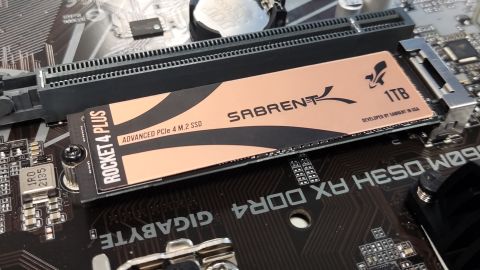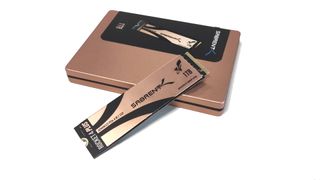Our Verdict
This update to the Rocket 4 Plus helps keep it competitive, but it's not quite the fastest or most affordable. Absolutely worth snapping up if the price drops though, and those large capacities are tempting for ultra-high-end systems.
For
- New NAND flash and firmware
- Strong synthetic reads and writes
- Solid real-world performance
Against
- Uses the same model name
- Not the fastest SSD
- Not the cheapest option either
PC Gamer's got your back
The original Sabrent Rocket 4 Plus launched in the winter of 2020 and while it wasn't quite the fastest drive around, it offered great performance at a decent price. Sabrent thinks it can do better than that though and has updated the firmware on the Phison PS5018-E18 controller and employed Micron B47R NAND TLC memory to improve the drive's performance.
Somewhat confusingly, Sabrent hasn't badged these new drives any differently from the original SSDs, so you potentially don't know which you're getting. Sabrent has said that all the original drives have now sold out, so everything on reseller's shelves should be from this new generation, although there's no way of telling from the packaging alone—the SB-RKT4P-1TB code is the same for both.
Once you've got the drive in your machine you can use the Sabrent Rocket Control Panel app to reveal the Firmware version. The newer drives have the R4PB47.2 firmware, whereas the original uses the RKT4P1.2 firmware. You can potentially check the NAND flash used as well, although to do that you're going to have to peel off the metal sticker on the front of the drive, which acts as a heatspreader in normal operation.
The drive is available in 1TB, 2TB, 4TB, and 8TB capacities, with prices ranging from $149 for the 1TB drive right up to $1,499 for the top capacity. You can also get the heatsink at the time of purchase, although this may not be needed, depending on the cooling offered by your motherboard and your current case configuration. If you're scouting it out for use in a Playstation 5, then it has a specific heatsink for that as well, which costs just an extra $10.
For reference, I benchmarked the drive without any additional cooling, not even that supplied by the motherboard manufacturer, and it maxed out at 70°C. That's warm, but nothing to be worried about, and far lower than the rated operating temperature of 85°C. It's also worth noting that you're unlikely to hit such temperatures under normal conditions, as benchmarking pushes drives far more than normal day-to-day use.
Before jumping into the benchmarks, it's worth highlighting the figures that Sabrent is quoting for this new drive: those are peak sequential read speeds of 7,000MB/s with writes on this 1TB model of 5,500MB/s. The 2TB and 4TB drives are said to have higher writes of 6,850MB/s and higher Random 4K IOPS of 650K as opposed to the 350K here.
Rounding out the specs, Sabrent quotes an endurance of 700TBW, which doubles up to 1400TBW for the 2TB model. You're looking at a 5-year warranty too, although to get that you are going to need to register your drive when you buy it—not an unreasonable ask, although you do have to remember to actually do it amid the excitement of installing a new SSD.








CPU: AMD Ryzen 5 5600X
Cooler: Zadak Spark AIO
Motherboard: Gigabyte X570 Aorus Master
RAM: 16GB Thermaltake DDR4 @3,600MHz
GPU: Nvidia RTX 3080
PSU: Ikonik Vulcan 1200W
Sabrent can be surprisingly conservative when it comes to its quoted sequential throughput, and sure enough, I saw higher figures on the writes in testing. You're looking at 5,875MB/s in CrystalDiskMark and 5,604MB/s in ATTO.
Beyond the write performance, things are pretty much as you'd expect from a second-generation PCIe 4.0 SSD. You're looking at strong performance, basically, particularly when it comes to the more synthetic benchmarks.
The issue for Sabrent here is that this performance is nothing to really get excited about. The likes of the WD Black SN850 pull out better numbers in PCMark 10 and in our real-world tests. The file copy, for instance, clocks in at 140 seconds, which is a couple of seconds slower than the WD drive.
This new version of the Sabrent can't compete when it comes to the load times in Final Fantasy XIV either, which still has the WD drive holding first place at under seven seconds. It's not lagging massively behind by any means, but given the WD drive costs the same as this drive right now, it's pretty obvious where your money should go.
The new version of the Sabrent Rocket 4 Plus is a welcome release, even if it doesn't dramatically alter the drive's place in the market. We've had faster drives released recently, like the Kingston Fury Renegade, along with more budget-focused offerings like the WD Black SN770, leaving the new Rocket 4 Plus in pretty much the same place as the original—not the fastest, nor the cheapest, but still worth shortlisting.
This update to the Rocket 4 Plus helps keep it competitive, but it's not quite the fastest or most affordable. Absolutely worth snapping up if the price drops though, and those large capacities are tempting for ultra-high-end systems.
Alan has been writing about PC tech since before 3D graphics cards existed, and still vividly recalls having to fight with MS-DOS just to get games to load. He fondly remembers the killer combo of a Matrox Millenium and 3dfx Voodoo, and seeing Lara Croft in 3D for the first time. He's very glad hardware has advanced as much as it has though, and is particularly happy when putting the latest M.2 NVMe SSDs, AMD processors, and laptops through their paces. He has a long-lasting Magic: The Gathering obsession but limits this to MTG Arena these days.

